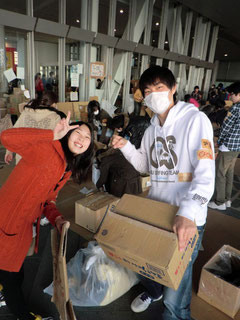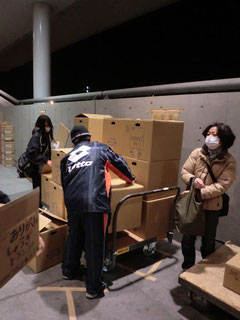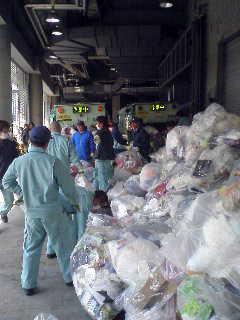69% of the houses in Minami Sanriku-cho are gone. There are still 200,000 houses in Tohoku without water. Along with members of the police, fire department and coast guard, 25,000 members of the JSDF and US military just finished a massive three-day sweep of the Sanriku Coast. Using helicopters, ships, and divers with sonar equipment, they found 77 bodies. 15,000 people are still listed as missing
The Fukushima reactor is going in circles. I think people in Tokyo have just gotten tired of being on edge, and are returning to everyday life minus a smattering of power and bottled water. I just saw a report on how women in Tokyo are buying more comfortable shoes because less escalators and elevators are working.
They’re tugging up a massive floating deck from Shimizu to store some of the radioactive water they’re pumping out of the Fukushima reactor. When I lived in Shizuoka, I used to go to the mall where that deck was docked. It’s right beside the port where the ferry came in from the Izu Peninsula.
Volunteering

Last week I chalked up three more circles on my “Volunteer” badge at Saitama Super Arena. I was moved by the way Takumi would dive in to help anyone within a three-yard radius, even leaping up from the middle of a conversation. Then, as I watched him offer assistance to one elderly woman, I realized that I had, in fact, been standing right in the same spot saying almost the exact same thing not five minutes before. I couldn’t help but wonder if other people hadn’t been watching me in the same way.
I was quite lucky that my job involved lots of running around and engaging with people. There was a guy whose job for three days had been to hold up a sign saying, “This is the end of the line.” He always seemed happy when I swung by to talk.
An elderly gentleman once hunkered down for a little chat as he perused the shoes. He asked me where I was from, and when I told him I was from Toronto, he responded that his home town was within three kilometers of the Fukushima nuclear power plant.
“I’ll never be able to go home, will I?” he said.
I wasn’t really sure what to say. I just quietly agreed, then offered a platitude about looking to the future. He didn’t seem sad—just reflective. There was always a tight balance to be walked between being friendly and being conscious of the reality of the situation.
Chef Mike

After the donations group split up at 4:00 on Tuesday, I stayed around to help with food distribution. I was handed a face mask and a big ladle and instructed to stir the massive vat of miso soup that was placed in front of me. Before we started, the organizer stopped and declared with all formality, “Thank you for not running back to your home country!”
It took me a minute and a half to stop laughing.
But it seems that 240,000 of us have indeed left. That’s roughly equivalent to the number of evacuees in all of Tohoku.
The food people were smart: They told me that stirring was very important and why, and I immediately felt like a vital member of the team, not just some guy with a ladle. If you don’t stir the soup, all the solid stuff sinks to the bottom, and not only do you end up with uneven distribution, you get some pretty salty dregs in the last quarter of the vat. For the next ten minutes, I didn’t see a single face as three volunteers dodged my ladle to fill an endless stream of paper cups with soup for the evacuees.
I washed dishes, made food trays from cardboard boxes, and finally ended up helping a guy who was sitting in a corner shredding cardboard. Mr. Cardboard told me he’d never volunteered before, but felt that he had to do something for everyone, and this seemed like the perfect opportunity to get involved. The next morning he even showed up on his way to work to make sure everything was okay.
During our Wednesday-morning briefing session, I ended up standing beside a guy with chains, long greasy hair, and a torn leather jacket. He introduced himself in English as Jun. It turns out that Jun is a 20-year Toyota mechanic who spent two years as an automotive consultant in Zimbabwe with the Japan Overseas Cooperation Volunteers (essentially the Japanese Peace Corps). He was offered a job with them at the end of his service, and now he’s studying to get a university degree so he can formally qualify for the position. He lives just a few blocks from me. When my time clears up a bit, I want to help him get the TOEIC score he needs for the job.
As of Wednesday, the donation drive was done, so our only job was to peel our tape markers off the concrete. They obviously hadn’t been thinking about clean-up when they’d set the place up, because they’d used packing tape, which came off at a rate of about 5 mm per minute. Chatting with one of the members of the Saitama Prefectural Social Welfare Committee, she said that, since there are never any disasters in Saitama, they’d been pretty disorganized at the beginning.
While trying to get a shot of one of our high school kids peeling a yard of tape off the ground, I managed to drop and break the little camera I’d bought in Hiroshima. I’d expected it to have a short life span, but not quite that short.
At 11:00, they gave up and told our small squatting army of tape-scrapers to stop and go home. A cleaning company would take care of the rest. I was, however, in luck: No sooner had we dispersed than Mr. Cardboard’s section head tracked me down to help with garbage detail. Then, when I turned around, I found that nearly all the high school kids had followed me.

We ended up in a stadium hallway filled with garbage, which a horde of teal-suited garbage men later stuffed into just five trucks. While we were down there, the first busloads of evacuees departed for their new temporary home. Of the 1721 evacuees, 1260 were going to Kisai High School, a decommissioned school that has now been retrofitted as a long-term evacuation center. The other evacuees were to be split among nine other locations in Saitama Prefecture, with the remainder to depart the next day.
Watching the buses go, it felt a bit like the flight from Hoth at the beginning of Empire Strikes Back. I guess that would make the garbage men sub-zero storm troopers.
When our group leader mentioned that TEPCO was helping the evacuees move, the revelation was met with silence and sidelong glances. He coughed and mumbled, "Well, I guess we can trust them with this much." Japanese people keep their criticism quiet, but it's clear that underneath it all, there's no trust for TEPCO any more.
Leaving the Arena that afternoon, I spotted a middle-aged refugee in the smoking area outside. He was wearing one of the T-shirts I had donated. It looked good on him.
I finally got called back to work the next day. Having spent four of the preceding six days handing out shoes to people with nothing to their names, my brain had to struggle to feel any sense of urgency for a marketing campaign. My boss seemed worried about how I’d react to the news that I would be getting a warning letter in addition to my week-long suspension, but on the shindo scale of things I’m concerned about, it registered at about a -1.
It’s time to look to the future, not to the past.

Write a comment